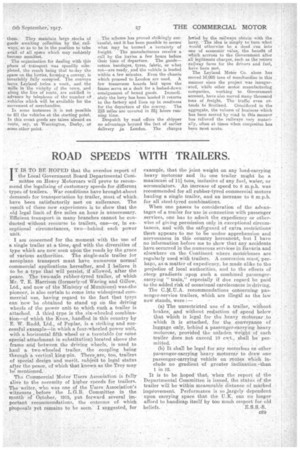ROAD SPEEDS WITH TRAILERS.
Page 5

If you've noticed an error in this article please click here to report it so we can fix it.
IT IS TO BE HOPED that the overdue' report of the Local Government Board Departmental Conitraittee on Heavy Motorcars will prove to recoin. inend.the legalizing of customary speeds for different
, types of trailers.. War conditions have brought about demands for transportation by trailer, most of which,. have been satisfactorily met on sufferance: The , result of these new experiences is to. show that the old legal limit of five miles an hour is unnecessary. Efficient transport in many branches cannot be conducted without recourse to trailers, one—or, in exceptional circumstances, two—behind each power unit. ., • I am concerned for the moment with the use of a single trailer 'at a time,and with the diversities of type which are now seen upon the roads by the grace
of various authorities. The single-axle trailer for aeroplane transport must have numerous normal commercial applications hereafter, and I .believe it to be a type that Will persist, if allowed, after the peace. The two-axle rubber-tyred trailer, of which Mr. T. E. Harrison (formerly=of Waring and Gillow, Ltd., and now of the Ministry of Munitions) was rthe pioneer, is also certain to come into widesfiread commercial use, having regard to the fact -that tyres can now be obtained to stand up on the driving wheels of the power unit to which such a trailer is attached. A third type is the six-wheeled combination—of which the Knox, handled in this country by E. W. RACI, Ltd., of Poplar, is a striking and successful example—in which a four-wheeled power unit, with a horizontal fifth wheel or a turntable (or some tsPecial attachment in substitution) located above the frame and between the driving wheels, is used to haul a two-wheeled trailer, the coupling being through a vertical. king-pin. Therytre, too, trailers of special design and merit, subject to legal status after the peace, of which that known as the Troy may
be mentioned.. , .
The Corr/Mei-6rd Motor Users Association is fully alive to the necessity of higher -speeds for trailers. The 'writer, who was one of the Users Association's witnesses . before the L.G.H. Committee in the month of October, 1915, put forward several important recommendations, the outcome of. which . proposals yet remains to be seen. I suggested, for
example, that the joint weight on any load-carrying heavy motorcar and its one trailer might be a maximum of 1112tons, inclusive of any fuel, water, or accumulators. An increase of speed to 8 m.p.h. was recommended for all rubber-tyred commercial motors hauling a single trailer' and an increase to 6 m.p.h. for all steel-tyred combinations.
When One passes to consideration of the advantages of a trailer for use in connection with passenger services, one has to admit the expediency or otherwise of giving permission only in exceptional circurntances, and with the safeguard of extra, restrictions therb appears to me to be undue apprehension and nervousness in this country hereanent, -but I have no information before me to show that any accidents have occurred in thenumerous services in Bavaria and elsewhere on the Continent where motorbuses are regularly used with trailers. A concession must, perhaps, as .a matter of expediency, be made alike to the prejudice of local authorities, and to the effects of steep gradients .upon such a combined passengercarrying " train," especially if due regard be paid to the added risk of occasional carelessness iirdriving.
The C.41.U.A. recommendations concerning passenger-service trailers, which are illegal as the law now stands, were :— , (a) The unrestricted use of a trailer, without brakes; and without reduction of speed below that which is legal for the heavy motorcar to which it is attached, for the conveyance of luggage only, behind a passenger-carrying heavy motorcar, provided the unladen weight of such trailer does not exceed 10 cwt., shall be per mitted. , .
(b) It shall be legal for any motorbus or. other passenger-carrying 'heavy motorcar to draw one passenger-carrying' vehicle on routes l'enich include no gradient of greater inclination!.than 1 in 12.
It is to be hoped that, when the report. of the Departmental Committee is issued, the status of the trailer will be within meaaurable distance of marked improvement. Performance is so largely dependent upon carrying space that the U.K. can no longer afford to handicap itself by too much respect for old
beliefs. F. S.
























